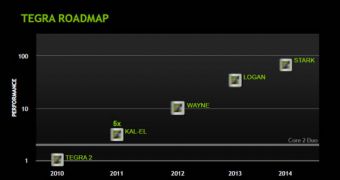Originally expected to arrive in 2013, Nvidia’s Project Denver chip, that combines multiple ARM processing cores with the company’s own graphics logic, won’t become available until 2014 or 2015, according to a recent report.
This info comes from the VR-Zone website, which has found out from unnamed sources that the first product to be based on the 64-bit Denver architecture will be the so called Stark chip, which is scheduled to be introduced in late 2014.
Furthermore, the SoC, that will be released into the Tegra family, isn’t expected to become widely available until 2015, which delays Project Denver’s arrival by another year.
As far as the specs of the chip are concerned, all that we have to go by at this time is a report that was published by BSN in July of this year.
According to this info, the chip will be fabricated using the 28nm process and will include 256 CUDA cores, based on the Fermi architecture, that will be clocked somewhere between 2.0 and 2.5GHz.
A similar frequency is also being used for the CPU, while the memory controller and the remaining components are designed to work at lower operating clocks.
To further improve the performance of the chip, Nvidia plans to use a new approach when it comes to accessing memory, and both the CPU and the GPU will be able to connect to the fast graphics memory via a controller that is similar to the one used in graphics cores.
To make the chip better suited for the server and workstation market, Nvidia will also introduce support for the 64-bit instruction set using a special architecture designed in house.
The first generation of Project Denver chips is expected to be used inside blade servers and for GPGPU Tesla systems, which currently require AMD Opteron or Intel Xeon processors in order to run the operating system and other basic tasks that can't be handled by the GPU.

 14 DAY TRIAL //
14 DAY TRIAL //